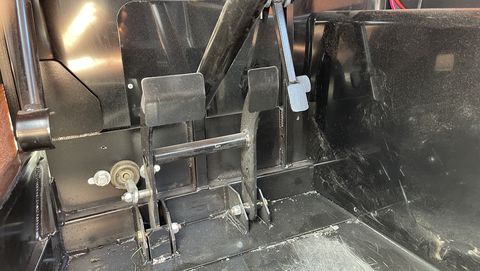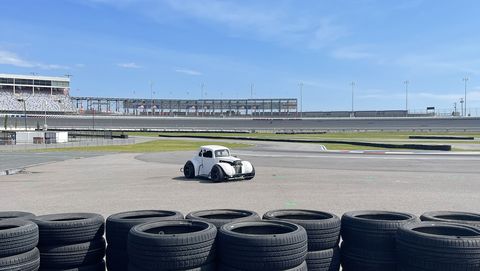Ezra Dyer: Legend Race Cars May Look Goofy But They're Serious Fun

From the October 2022 issue of Car and Driver.
Ignore the goofy body. The Legend car looks the way it does—like a nitromethane Shriner fever dream—because that’s the basic shape of a human sitting upright behind a motorcycle engine. Thus the bodywork takes the form of a 1930s Ford or Chevy coupe, 5/8 scale, recalling the prewar bootlegger hotrods that spawned NASCAR. What else could it really look like? Nobody wants to race a Converse All-Star.
But that composite body, cheery and cartoonish, is draped over a real-deal race car. A 12,000-rpm Yamaha FZ09—three cylinders, 847-cc, fuel-injected and water-cooled—drives the rear wheels through a six-speed sequential transmission mated to a locked rear end. The Yamaha makes 125 horsepower in a car that weighs about 1100 pounds (rules stipulate that cars must weigh at least 1230 pounds with the driver after a race). That’s a stout power-to-weight ratio to squeeze into a 74-inch wheelbase. Models built before 2018 used larger air-cooled four-cylinder engines with carburetors, 1200 cc or 1250 cc, and those still race alongside the FZ09 cars. The big engines put down a lot more torque, 100 pound-feet at the wheels versus the FZ09’s 75 pound-feet, but that doesn’t really confer an advantage when you’re running 13-inch-diameter bias-ply tires. Traction, not power, is always the limiting factor.

If all that sounds to you like a recipe for good times, I’d agree. So, I ventured to Charlotte Motor Speedway to try a Legend car on the 13-turn infield kart track, which was designed to FIA specifications to host world championship events and is not to be confused with the setup at Jimbo’s Go-Karts and Putt-Putt Emporium down at the seedy end of your local beach. At Charlotte, I met Graham Smith, managing director of US Legend Cars International; G.E. Chapman, general manager of the company; and Darren Amidon of Darren Amidon Racing. All three go deep with their knowledge of, and enthusiasm for, these little race cars.
“Legends race in 39 states and 28 countries,” Smith tells me as we approach the test car, which wears an unadorned plain white body, Ricky Bobby with no sponsors. “They’re big in Finland. And there are series for dirt, asphalt oval, and road course. You can set them up for anything.” I suggest ice racing, and it turns out that’s been done—just try to keep Swedes from throwing studded tires on a rear-drive car.

Ezra Dyer|Car and Driver

Ezra Dyer|Car and Driver

Ezra Dyer|Car and Driver
Amidon and Anderson help get me belted into the car, which requires some adjustment because the previous driver was a kid. This is one of the few race machines that accommodate a 12-year-old (Young Lions division, ages 12-15) and then an adult racing on the same night. The Masters division, where I would land, is for ages 40-plus and often sees the most ferocious competition. A tachometer is the only instrument, and the quick-release steering wheel is flanked by a thin shift lever to the right. The clutch pedal is far to the left and its pad seems about the size of a quarter, keeping itself out of the way because you only need it to get moving. The brake pedal is shaped like a wide U with the steering column protruding through the middle so that you can brake with either your left or right foot. And that’s about it. Smith cautions that the bias-ply Hoosiers will take a few laps to heat up, and I’m sent off to figure the rest out for myself.
About 10 minutes later, I’ve mainly figured out that I need a Legend car in my life. My older son is 12, and driver ed just isn’t going to teach him what he needs to know about 10,000-rpm upshifts out of Turn 7. And for me, spending time teasing out the limits of four contact patches is sort of like earning a continuing education credit, right? Or maybe you don’t really need any justification, beyond the quest for a race car experience that doesn’t require a Formula One budget or a degree in engine building from Fenway Roush University.

Ezra Dyer|Car and Driver
And a Legend car certainly delivers full sensory immersion, engine screaming through its stubby exhaust as you wrestle it through corners, lurid slides costing time but paying off in silly fun. On the brakes, you get angry pops from the exhaust accompanied by gentle deceleration—the front rotors are 10-inch Wilwoods, but the rear end uses Toyota drums. Trail braking seems like the move, inducing that locked rear end to relinquish its grip on the pavement just a little bit and get down with the business of turning. Once it takes a set, the Legend feels like it has plenty of grip, but any move to upset it, whether via throttle or brake or a breath of steering lock, can summon a slide. Smoothness is rewarded, clumsiness punished. Which is true of any car, really, but the feedback here is news you can use in real-time, immediate and visceral. Get slightly greedy with the throttle in a slow corner and you won’t just feel the understeer—you can see it, front tires right out there past your ankles, scribing the message that sometimes you have to go slow to go fast.
All of which is wonderful. But the real appeal here is that the Legend formula removes bottomless money and mechanical aptitude as necessary precursors to participation. Cars cost $17,500 new, and you can’t spend your way to competitiveness. Engines are sealed, specs are tight, and parts are cheap. The biggest difference between any two cars is who’s in the driver’s seat. You can find used ones with the older air-cooled engines ready to race for about $5000.

Ezra Dyer|Car and Driver

Ezra Dyer|Car and Driver
Amidon gestures to one of the front Bilstein dampers and says, “Those shocks were $100 when these cars first came out in 1992. They’re still $100.” And that’s not just one unusually cheap part—a fender, for instance, is $85. “Say you’d put it into the wall and tore the front corner off,” Chapman says. “Fixing it would cost, oh, a few hundred dollars.” Engines can last multiple seasons, and when they need a rebuild, it’s $2400. Contrast that with karts, where in some classes competitive engine life is measured in races, not seasons, and a new engine can run $10,000 by itself. Even the tires last forever, in race-car terms. “The tires on this car probably have 600 laps on them, and they’d be legal for a race right now,” Smith says. “A new set of tires might give you an advantage for one heat, but after that, it evens out.”
Legend alums include many big NASCAR names, such as Bubba Wallace and Joey Logano. The series can be a steppingstone toward grander racing ambitions. Or you can just have a blast, racing on weekends for bragging rights and adrenaline, going nowhere fast.
This content is imported from OpenWeb. You may be able to find the same content in another format, or you may be able to find more information, at their web site.



